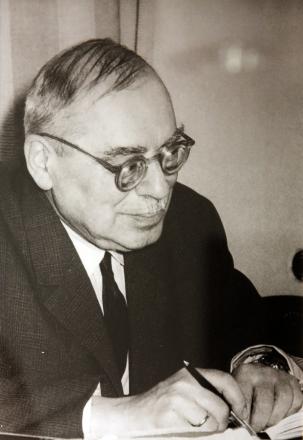The sixties and seventies
The period of the beginning of the 1960s was a period in which the role of physics became significant both in the teaching of technical departments and scientific research.
This was well understood by prof. Szczepan Szczeniowski - head of one of the four departments scattered around various faculties of the university - and mainly thanks to his efforts, on September 1, 1965, the Interdepartmental Institute of Physics of the Warsaw University of Technology was established. Professor Szczeniowski becomes its first director. This is what one of his closest associates, prof. J. Kociński:
Professor dr hab. Szczepan Szczeniowski, (December 26, 1898 - February 18, 1979) received his doctorate in 1926 in the field of experimental physics at the University of Warsaw, under the supervision of prof. Stefan Pieńkowski. He obtained his habilitation in 1930 in the field of theoretical physics also at the University of Warsaw. Professor of physics successively at universities: Jan Kazimierz in Lviv, them. Stefan Batory in Vilnius, them. Adam Mickiewicz in Poznań and at the Warsaw University of Technology. The founder of the Polish scientific school in the field of ferromagnetism. Full member of the Polish Academy of Sciences. Honorary doctor of the University of A. Mickiewicz in Poznań. For many years he was the chairman of the team leading scientific research in the field of ferromagnetism in the countries of Eastern Europe. Supervisor of forty-three doctors in the fields of solid state physics, structural analysis and optics. During his lifetime, seven of them obtained habilitation and six obtained the academic title of professor of physics. He reviewed over two hundred and sixty doctoral and postdoctoral dissertations. Author of a six-volume academic textbook "Experimental Physics", which served most of the Polish physicists of the post-war generation and the number of university students. In the years 1937-1939 he was the editor-in-chief of the journal "Acta Physica Polonica". In 1949 he initiated the periodical "Postępy Fizyki", of which he was the first editor. Organizer and from 1965 the first director of the Institute of Physics of the Warsaw University of Technology. A scholar with a wide range of interests, including history, literature and, in general, various aspects of physics, in which he ranked the exact sciences first. He always found time for anyone who asked him for advice or help. Decorated with the Commander's Cross with the Star of the Order of Polonia Restituta.
The entire teaching process was taken over by the Institute only in 1970, when the departments were liquidated and all employees were incorporated into the Institute. The Institute then became a large non-departmental unit with approximately 180 employees. During this period, scientific research was carried out, mainly continuing the issues that were in the profile of interests of former departments. Contracted activities related to physical and technical issues were also undertaken.
In the mid-1970s, the Institute of Physics was already a unit with a transparent, properly functioning organizational structure, employing over 200 people, including 3 professors and 11 associate professors. The value of the contract work was approximately PLN 20 million. The general profile of scientific research of the Institute included the problems of physics related to a large extent with technology, i.e. the ways of applying physics methods, the apparatus base of physics and the results of physical research in technology, industry and various fields of science, as well as a set of methods and technical apparatus used to solve problems in physics. The main areas of research were the study of the physical properties of materials in various external conditions and the study of the structure of matter. The following sections were represented: high pressure physics, solid state physics, acoustics and ultrasound, quantum optics, ferroelectrics and ferromagnetics, organic and amorphous semiconductors, atomic nucleus and elementary particles, liquid crystals, thermal properties of materials. At the time when the director of the Institute was prof. Zbigniew Strugalski, there were 5 teaching facilities servicing the relevant departments, and the scientific activity was organisationally covered in 9 scientific departments:
- Mechanics Problems (head of doc. Roland Wiśniewski)
- Solid State Physics (head of doc. Wojciech Jabłoński)
- Acoustics and Ultrasound (director Czesław Wachtl)
- Quantum Optics (director of doc. Jan Petykiewicz)
- Amorphous and Organic Semiconductors (head of prof. Bogna Klarner)
- Atomic and Molecular Optics (head Dr. Zenon Tomczak)
- Problems of Contemporary Physics (director of doc. Włodzimierz Zych)
- Physics of the Atomic Nucleus and Elementary Particles (headed by Prof. Z. Strugalski)
- Problems of Didactics (director Witold Kruczek Ph.D.)
At the end of the 1960s, the question of launching studies at the Warsaw University of Technology in the field of the so-called technical physics.
The idea of educating "technical physicists" as part of an organized faculty dates back to the pre-war period and was given in 1932 by Professor Mieczysław Wolfke at the 6th Congress of Polish Physicists in Warsaw. Here is an excerpt from this reading:
In order to implement the above-outlined postulates, one should first of all think about the education and preparation of serious employees in the field of technical physics. So far, we do not have a single technical physics department in Poland. At the Lviv Polytechnic, there are the beginnings of such a course of education at the General Faculty, and at the Warsaw Polytechnic at the Faculty of Electrical Engineering, where diploma and doctoral theses are carried out in the field of technical physics ... Warszawska. For various reasons, the education of technical physicists should take place in the capital, where contact with the interested spheres is easier. The program of such a section would have to be adapted to the needs of our state and could be partially modeled on the programs of foreign universities of technology. Interest in this matter should also be awakened in the affairs of industry and the broader layers of technicians and physicists. For this purpose, it would be very desirable to establish a Polish technical physics society or, at first, within the Polish Physical Society - a technical physics section. A very important factor for the successful development of a new branch of knowledge is the ability to publish papers in a central own body. In this regard, I suppose that it will be possible, in consultation with the editors of our "Acta Physica Polonica", to create an appendix devoted to works in the field of technical physics. All the above-mentioned projects have one common goal - to create a new field of creative work for technology, based on the strong scientific foundations of pure physics, according to the principle: let's remain physicists, and let's work for technology.
He returned to this idea as the director of the Institute of Physics, professor Szczeniowski, promoting it at the higher levels of higher education authorities and preparing the ground at the University of Technology for the implementation of this idea. The next directors of the Institute were further involved in this matter - professor B. Karczewski and professor Z. Strugalski.
In 1973, the Mathematical and Technical Study at the Faculty of Electronics was transformed into the Study of Fundamental Problems of Technology and included three specialties: applied mathematics, technical physics and applied mechanics. At that time, new study plans and curricula were developed and implemented, and the type and size of internships were established, based on the experience gained so far. The ministerial commission coordinated the work on the programs of the first years of study (professor J. Massalski was the chairman of the Physics Commission, associate professor W. Zych was a member of the Institute of Physics of the Warsaw University of Technology), the programs of older years were developed within individual universities. In the 1973/74 academic year, the first students (25 people) were admitted to the specialty of Technical Physics. On October 1, 1974, the Study of Fundamental Problems of Technology was granted the Faculty's rights. Prof. dr hab. Tadeusz Traczyk, deputy for mathematical studies - doc. dr hab. Henryk Adamczyk, for physical studies - doc. dr hab. Włodzimierz Zych.
The programs approved by the Ministry of Higher Education and Technology included four specializations: Solid State Physics, Optics, Nuclear Physics, Liquid and Gas Physics, and Solid State Physics and Optics were handed over for implementation.
In February 1975, the Rector of the Warsaw University of Technology, after making the decision to organize a new faculty, appointed a team to prepare "Assumptions for the program of tasks and development of the Institute of Mathematics, Physics and the Study of Fundamental Problems of Technology at the Warsaw University of Technology until 1990" (from the Institute of Physics, the team members were associate professor R . Wiśniewski and W. Zych), as part of the university-wide document entitled "Assumptions for the development program of the Warsaw University of Technology in Warsaw until 1990". It was to be a document that would constitute the basis for the activities of the Faculty and Institutes for the following years, taking into account the tasks related to the education of physicists and mathematicians.





